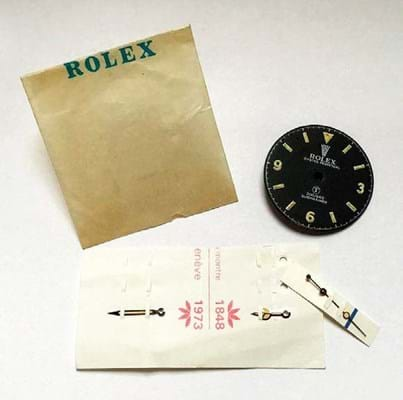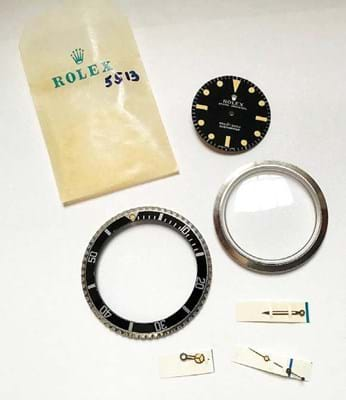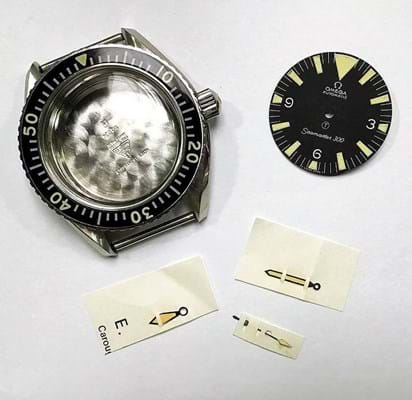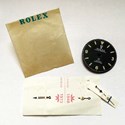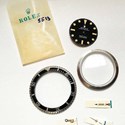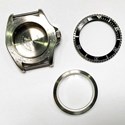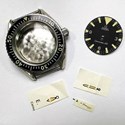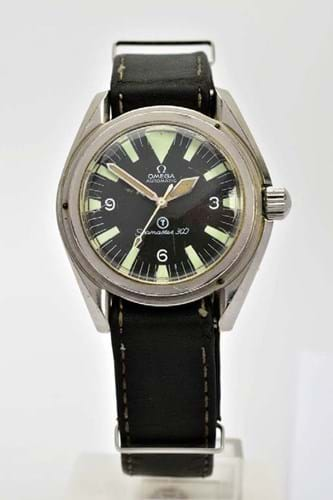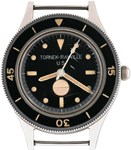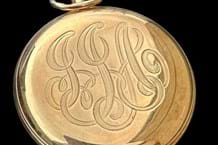The initials NOS that occasionally accompany a branded wristwatch or watch part are guaranteed to pique the interest of collectors. ‘New Old Stock’ offers the prospect of owning a discontinued or ‘retired’ model in near pristine, unworn condition.
NOS is not uncommon for the many collectable modern issues that were occasionally shelved by a retailer in favour of the season’s newest arrivals.
Rarely, however, does it refer to watches or parts from the vintage era.
Strong naval connection
A Nesbits (19% buyer’s premium) auction in Portsmouth on October 7 attracted multi-estimate sums from online buyers for a small parcel of Omega and Rolex parts – replacement dials, cases and hands from well-known 1960s models – which came for sale from a vendor who acquired them many years ago from a local watchmaker.
The area has a strong connection with naval wristwatches in particular: many Ministry of Defence issues were owned (and occasionally sold under the counter for cash) by mariners in the port city.
The most ‘complete’ of these half-dozen lots was the bare bones of an Omega Seamaster 300.
As well as a stainless steel case with its screw-down crown and glass, it featured an acrylic resin bezel, wide ‘sword’ hands and a matt black ‘big triangle’ dial. The case retained its blue paper label to the back with the hands still resting in their card packaging.
All that would be required was a period-correct strap and the small matter of an Omega calibre 552 automatic movement. The auction house’s estimate of £400-600 had encouraged many dealers and collectors to dream of a cheap ‘fixer-upper’. In fact, the hammer price was £7400. Nesbits had sold a similar lot for the same vendor last year for around £4000.
Question answered
What is a decent Seamaster 300 currently worth at auction in original condition? Anyone asking that question had just a matter of days to wait.
The 1968 Ref 165024 offered by Richard Winterton (20% buyer’s premium) in Lichfield on October 19 came for sale following a routine valuation for a local client. It had British Army marks to the case back and the curved and bevelled lugs and fixed spring bars that are more subtle features of a military-issue watch.
Pitched at an alluring £1000-1500 (it was missing a bezel and had some restoration to the dial), it attracted interest from across the globe, ultimately selling for £25,000 to a buyer in Hong Kong via thesaleroom.com.
Back at Nesbits, similar levels of competition greeted two replacement dials for the Rolex Submariner 5513 – a watch adopted by the Royal Navy in 1968. The regulation example, together with a replacement bezel, glass and ‘Mercedes’ hands sold at £4300 (estimate £400-600), but bid to £8800 (estimate £200-300) was the rarer ‘Explorer’ dial with 3-6-9 markers.
It was in the early 1960s that Rolex released this new version of the 5513 with markers made using the isotope tritium and an encircled T to the lettering. Until this point, radium had been used by most watch manufacturers, but was discontinued once the health risks became apparent.
Also sold at £8800 was a lot of parts that included a replacement stainless steel case for an earlier Rolex Submariner: the 5512.
This is the model of watch that (with a rare dial configuration, box and papers) sold for £175,000 at Gardiner Houlgate in Corsham on October 21 (see News, ATG No 2465). Dating from c.1961, this case with the serial number 693323 was a variant with pointed crown guards. It was sold together with a replacement bezel and glass way over a guide of £300-500.
The watch market currently places a huge emphasis on period correct elements. While nothing will better the ‘time capsule’ watch that retains all its original factory elements, a correct NOS part is perhaps the next best thing.


